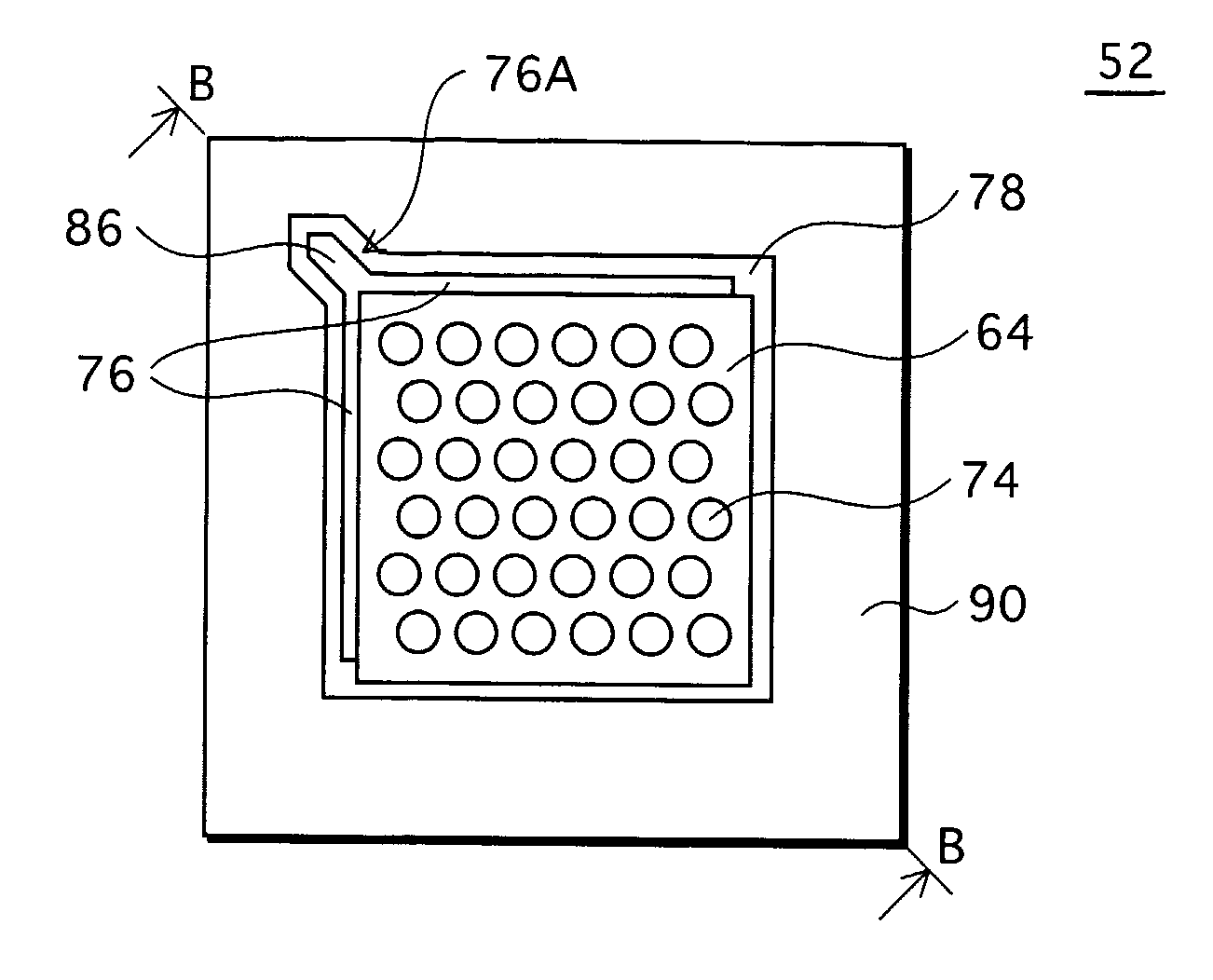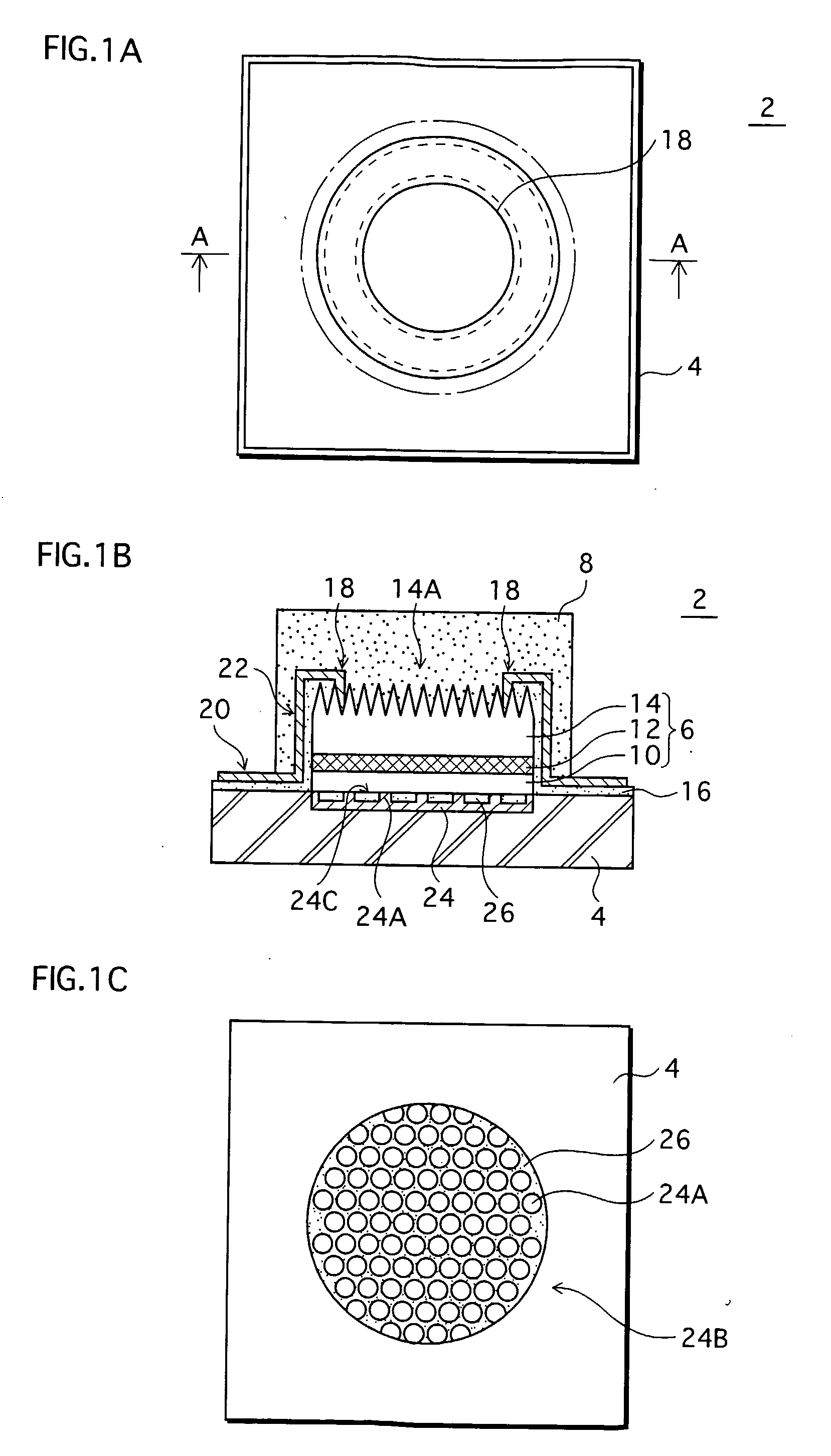Nitride based led with a p-type injection region
a technology of nitride and injection region, which is applied in the manufacture of semiconductor/solid-state devices, semiconductor devices, and semiconductor devices. it can solve the problems of reducing the internal quantum efficiency, reducing the efficiency of internal quantum efficiency, and difficulty in manufacturing a p-semiconductor layer having low resistance, so as to improve the ratio of electron-hole recombination and emission light.
- Summary
- Abstract
- Description
- Claims
- Application Information
AI Technical Summary
Benefits of technology
Problems solved by technology
Method used
Image
Examples
embodiment 1
[0057]FIG. 1A is a plan view showing the schematic structure of a white LED chip 2 (hereinafter, simply “LED chip 2”), which is a semiconductor light emitting device. FIG. 1B is a sectional view taken along the line A-A of FIG. 1A. In FIG. 1A, a later-described phosphor film 8 is removed (the phosphor film 8 is shown in phantom in dot-dash lines). Note that in FIG. 1 as well as in the other figures, components are not shown on the same scale.
[0058] As shown in FIGS. 1A and 1B, the LED chip 2 is composed of: a metal substrate 4 as a base substrate; a disk-shaped (columnar) semiconductor multilayer structure 6 disposed on the metal substrate 4; and the phosphor film 8 covering the upper and side surfaces of the semiconductor multilayer structure 6. The metal substrate 4 is made of gold (Au). The dimensions of the entire LED chip 2 are as follows: the metal substrate 4 is a 500 μm square and 50 μm thick, and the phosphor film 8 is 460 μm in diameter and 200 μm in thickness.
[0059] The...
embodiment 2
[0105]FIG. 8A is a plan view of a white LED chip 52 (hereinafter, simply “LED chip 52”), which is a semiconductor light emitting device, whereas FIG. 8B is a sectional view taken along the line B-B of FIG. 8A. FIG. 9A is a bottom view of the LED chip 52. Note that FIG. 8A shows the LED chip 52 from which a later-described phosphor film 58 (see FIG. 8B) is removed.
[0106] As shown in FIG. 8, the LED chip 52 is composed of a high-resistance Si substrate 54 (hereinafter, simply “Si substrate 54”) as a base substrate, and a semiconductor multilayer structure 56 and the phosphor film 58 laminated over the Si substrate 54. The Si substrate 54 has a main surface slightly larger than that of the semiconductor multilayer structure 56. The semiconductor multilayer structure 56 is disposed centrally on one main surface of the Si substrate 54.
[0107] The semiconductor multilayer structure 56 has a quantum well structure composed of: a p-AlGaN layer 60 (200 nm thick), which is a p-semiconductor ...
embodiment 3
[0155] In the above embodiments 1 and 2, a semiconductor multilayer structure is initially formed on a sapphire substrate (single crystal substrate) and later bonded to a substrate of different material, such as a metal or a semiconductor. In an embodiment 3, the present invention is applied to a well-known LED chip that is manufactured by epitaxially growing a semiconductor multilayer structure on a single crystal substrate, such as an SiC substrate or sapphire substrate, and thus without involving separation of the semiconductor multilayer structure from the single crystal substrate.
[0156]FIG. 18 show an LED chip 112 according to the third embodiment. FIG. 18A is a plan view of the LED chip 112. FIG. 18B is a sectional view taking along the line C-C of FIG. 18A. FIG. 18C is a plan view exclusively of a p-electrode 126, which will be described later. Note that FIGS. 18C and 18D and FIG. 19 all show the p-electrode in plan view, and the solidly shaded areas represent the projected ...
PUM
 Login to View More
Login to View More Abstract
Description
Claims
Application Information
 Login to View More
Login to View More - R&D
- Intellectual Property
- Life Sciences
- Materials
- Tech Scout
- Unparalleled Data Quality
- Higher Quality Content
- 60% Fewer Hallucinations
Browse by: Latest US Patents, China's latest patents, Technical Efficacy Thesaurus, Application Domain, Technology Topic, Popular Technical Reports.
© 2025 PatSnap. All rights reserved.Legal|Privacy policy|Modern Slavery Act Transparency Statement|Sitemap|About US| Contact US: help@patsnap.com



